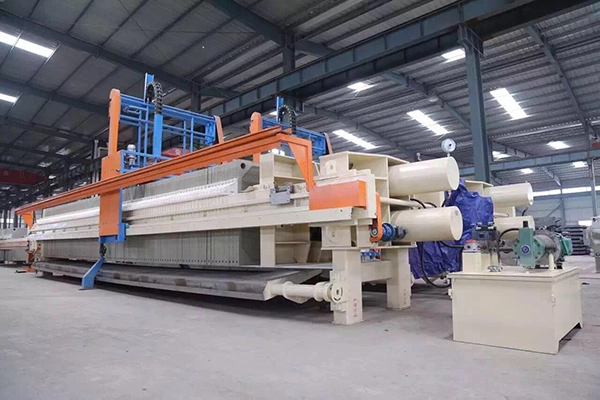Principle of plate and frame filter press
Plate and frame compressor, commonly known as plate and frame filter press, is a solid-liquid separation equipment widely used in chemical, pharmaceutical, food processing and sewage treatment fields. The working principle is based on the process of physical compression filtration, and the main structure includes filter plates, filter frames, pressing mechanisms and feeding systems.
1. Structural composition: The plate and frame filter press is composed of multiple filter plates with convex and concave patterns and filter frames arranged alternately and assembled on the frame. In simple terms, it consists of the following parts:
Filter plate and filter frame: The core components of the plate and frame compressor. The filter plate is usually fixed, while the filter frame is movable. A closed filter chamber is formed between the two. Pressing mechanism: Responsible for applying pressure to the filter plate, causing the liquid to be discharged through the filter cloth, and the solid is trapped in the filter chamber. Feeding system: Feeds the material to be filtered into each filter chamber.
2. Workflow The plate and frame are generally made into a square, and the corners of the plate and frame are opened with round holes, as shown in the figure above. After assembly and compaction, the round holes at the corners are connected to form a channel for the flow of slurry, filtrate or washing liquid. The two sides of the frame are covered with filter cloth with holes at the four corners. The empty frame and the filter cloth form a space for accommodating filter slurry and filter cake. The filter plate is divided into two types: washing plate and filter plate. There is also a side channel in the round hole in the upper left corner of the washing plate, and the washing water can enter the frame from this channel. For easy distinction during installation, small buttons or other signs are often cast on the outside of the plate and frame. Usually, the filter plate is cast with one button, the frame is cast with two buttons, and the washing plate is cast with three buttons. When assembled, the plate and frame are arranged in the order of buttons 1-2-3-2-1-2... The drive of the clamping device can be manual, electric or hydraulic transmission.
During filtration, the suspension enters the frame through the dark hole at the corner of the filter frame through the filter slurry channel at a specified pressure. The filtrate passes through the filter cloths on both sides and then drains along the adjacent plate surface to the filtrate outlet. The solids are retained in the frame. When the filter cake fills the filter frame, the filtration stops. There are open flow and dark flow for filtrate removal, as shown in the figure.
If the filter cake needs to be washed, the washing water can be pressed into the washing water channel and enter between the plate surface and the filter cloth through the dark hole at the corner of the washing plate. At this time, the filtrate outlet at the bottom of the washing plate should be closed, and the washing water will pass through the filter cloth-the entire filter cake thickness-the filter cloth on the other side in turn under the pressure difference, and finally be discharged from the filtrate outlet at the bottom of the filter plate. This is the cross-washing method, and its function is to improve the washing effect.
After washing, unscrew the clamping device, pull open the filter frame, unload the filter residue, clean the filter cloth, reassemble, and then enter the next operation cycle. It can be seen that the filtering operation usually includes filtering, washing the filter cake, dehumidifying, unloading, reassembling (intermittent filter) and other stages, which constitute an operation cycle.
Feeding: The suspension (mixed liquid containing solid particles) is fed into each filter chamber from the feed port.
Filtration: As the filter chamber is filled, the suspension flows out through the filter cloth under pressure, and the solid particles are trapped to form a filter cake.
Pressing and dehydration: After the initial filtration, the water content in the filter cake is further reduced by increasing the pressure of the pressing mechanism, thereby improving the solid recovery rate and dryness.
Unloading: After the pressing is completed, open the filter press, remove the filter cake, clean the filter cloth, and prepare for the next round of filtration.


